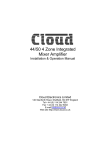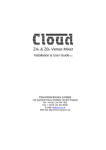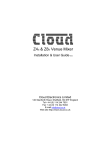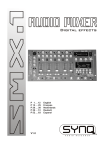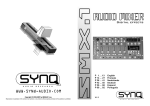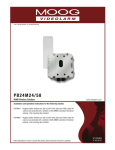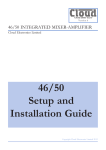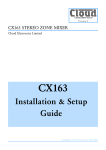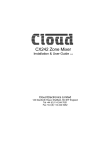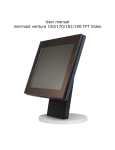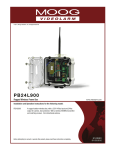Download Cloud 36 Specifications
Transcript
36/50 2 Zone Integrated Mixer Amplifier Installation & Operation Manual V5.0 Cloud Electronics Limited 140 Staniforth Road, Sheffield, S9 3HF England Tel + 44 (0) 114 244 7051 Fax + 44 (0) 114 242 5462 E-mail [email protected] Web site http://www.cloud.co.uk 36/50: Installation and Operation Manual 1 36/50 Integrated Two Zone Mixer Amplifier Installation and Operation manual Contents Section 06/12/02 V5.0 Page 1 Safety Notes...............................................................................2 2 General Description ...................................................................2 3 Schematic Diagram ....................................................................2 4 Installation ..................................................................................3 5 Music inputs ...............................................................................3 6 Sensitivity & Gain Control...........................................................3 7 Music Control – Local or Remote ...............................................3 8 Music Equalisation .....................................................................4 9 Priority ........................................................................................4 10 Microphone Input .......................................................................5 11 Microphone Access Inputs .........................................................5 12 Microphone Gain Control ...........................................................6 13 Microphone Equalisation ............................................................6 14 Microphone Level Controls.........................................................6 15 Microphone Priority ....................................................................6 16 Utility Output...............................................................................6 17 Speaker Output Details ..............................................................7 18 100V or 70V Line Operation.......................................................7 19 Bose Speaker Equalisation Cards............................................7 20 Remote Music Mute – Fire Alarm Interface ................................8 21 Installing RSL-6 or RL-1 Remote Controls .................................8 22 Controlling two or more zones with one RSL-6 ........................10 23 Controlling two or more zones with one RL-1...........................10 24 Controlling the music functions using external DC control .......10 25 Solving Problems .....................................................................10 26 Default Jumper Settings ...........................................................11 27 EMC Considerations ................................................................11 28 Technical Specifications...........................................................12 29 General Specifications .............................................................12 2 1 36/50: Installation and Operation Manual Safety Notes • Do not expose the unit to water or moisture. • Do not expose the unit to naked flames. • Do not block or restrict any air vent. • Do not operate the unit in ambient temperatures above 35oC. • Do not touch any part or terminal carrying the hazardous live symbol ( ) while power is supplied to the unit. • Do not perform any internal adjustments unless you are qualified to do so and fully understand the hazards associated with mains operated equipment. • The unit has no user serviceable parts. Refer any servicing to qualified service personnel. • If the moulded plug is cut off the lead for any reason, the discarded plug is a potential hazard and should be disposed of in a responsible manner. For more detailed information refer to the rear of the manual. 2 General The Cloud 36/50 is a versatile, multi-source two zone mono mixer with integrated power amplifiers. The 36/50 has one 50 watt power amplifier for each zone plus an additional 50 watt ‘utility’ output. The unit has applications where one microphone and six line level music signals are required to feed up to three separate areas. A facility for connecting remote controls for the music source and level are provided. For line distribution systems, optional four channel 100V/70V line transformer modules are available. The front panel controls are reduced to a minimum to reduce confusion; if preferred, the unit can be positioned in a protected area with just the remote music level and source controls positioned in the most appropriate location. All pre-set controls are on the rear panel. A remote music mute facility is provided which may be used to satisfy the requirements of the Local Fire Officer. 3 06/12/02 V5.0 Schematic Diagram 36/50: Installation and Operation Manual 4 3 Installation The Cloud 36/50 is suitable for mounting in a standard 19" equipment rack and occupies two units of rack space. Sufficient ventilation should be provided particularly where the unit is required to deliver a high output power for a long period of time. The cooling is provided by convection and the airflow through the ventilation slots must not be obstructed. In rack mounting applications we recommend that 1U of space is left both above and below the unit, though this may not be necessary if other equipment directly above and below the unit does not cover the ventilation slots. In free standing applications the feet supplied should be fitted, the unit stood on a flat surface and precautions should be taken to ensure that items will not be placed on top of the unit that may cover the ventilation slots. The 36/50 is 300mm deep but a depth of 375mm should be allowed to clear connectors. 5 Music Inputs The 36/50 operates in mono but is fitted with six stereo line inputs, which are internally mixed to form mono signals. The line inputs are suitable for most music sources such as compact disc players, tape players and receivers etc. All the inputs are unbalanced and use RCA type phono sockets. The input impedance is 47kΩ. 6 Sensitivity & Gain Control All six line inputs have a pre-set gain control on the rear panel adjacent to the respective input sockets. The input sensitivity can be varied from -12dBu (195mV) to +8dBu (2.0V). The pre-set gain controls should be set so that all the input signals operate at the same level within the unit and the music level controls have an optimum range of control. For nominal operating levels the figure below gives a rough guide to settings for typical equipment, though as there is little in the way of standards Typical Gain Settings for the output levels of CD players, tape players etc It is likely that some experimentation will be needed to find precisely the right levels. When setting the gain controls to achieve the maximum output level it should be noted that the unit has clip limiters on all the power amplifier sections. These clip limiters can give a false impression of the signal level, allowing the user to set the input gain controls to inappropriately high levels without noticeable clipping. 7 Music Control - Local or Remote The music source and music level control functions can be controlled from either the front panel, or a remote control plate located up to 100m from the 36/50. There are two remote control plates available for the 36/50 the RSL-6 and the RL-1. The RSL-6 should be used when remote control of music source and music level is required whereas the RL-1 can be used when the application calls for remote control of the level only (source selection via front panel). RSL-6 and RL-1 remote control plates can be mounted onto a standard British flush or surface mounted 25mm deep back box. Two-core cable with overall screen should be used to connect the remote controls to the Cloud 36/50, the diagrams to the right show how to connect the two remote plates. See section 21 for installation details. 06/12/02 V5.0 4 36/50: Installation and Operation Manual The RSL-6A and RL-1A are available for the American market. They have identical operation to the RSL-6 and RL-1 but have been designed to fit a single gang US electrical outlet box. Front panel dimensions are 4 1/2”×2 3/4” 8 Music Equalisation Separate treble and bass controls are provided for music signals on each zone. This arrangement allows the installer to optimise the response of the music signals on a zone by zone basis where different acoustic properties require optimal equalisation adjustment. The equalisation controls are on the rear panel. The music treble control (HF) has a range of ±10dB at 10kHz and the music bass control operates with a range of ±10dB at 50Hz. 9 Priority The Cloud 36/50 has a facility to allow fully automatic priority to a JukeBox or Spot Announce Player on both zones. Internal priority jumpers J12 (Zone1) and J13 (Zone2) can be repositioned to the ‘ON’ position to enable this in either or both zones. Jumpers J12 and J13 can both be found located approximately 150mm behind the Zone 2 microphone level control Location of Jumpers J12 and J13 When this priority mode of operation is selected, the zone will operate normally until a signal is detected on Line Input 6; this will cause the selected signal (usually background music) to mute, allowing the signal on Line 6 to operate with priority. Once the signal on Line 6 ceases, the selected music signal will smoothly restore to its former level; the time taken for this restoration can be set at 3, 6 or 12 seconds by fitting the appropriate jumper (J11) on the main printed circuit board. The factory default restoration time is 3 seconds. Location of Jumper J11 When setting the jumper(s) please ensure that you: • Remove the mains cable from the rear of the product before removing the top panel. • Only reassemble the unit using bolts/screws identical to the original parts. 06/12/02 V5.0 36/50: Installation and Operation Manual 10 5 Microphone Input Location of Jumper J1 A microphone input is provided, the microphone pre-amplifier is an electronically balanced, transformerless design configured for optimum low noise performance. The input impedance is greater than 2kΩ and is suitable for microphones in the 200Ω to 600Ω range. The input is via a gold plated 3-pin XLR type connector with latch and this is positioned on the rear panel. For a balanced microphone, connect the cable screen to pin 1, the in-phase signal (+) to pin 2 and the reverse phase signal (-) to pin 3. For an unbalanced microphone, connect a wire link from pin 1 (ground) to pin 3 inside the XLR cable mounted plug; use pin 1 as ground (cable screen) and pin 2 as hot. Phantom power is available by setting internal jumper J1 to the ‘ON’ position. When setting the jumper(s) please ensure that you: • Remove the mains cable from the rear of the product before removing the top panel. • Only reassemble the unit using bolts/screws identical to the original parts. • Use a microphone that requires phantom power. 11 Microphone Access Inputs The 36/50 has microphone access contacts to facilitate the connection of a paging microphone. Internal jumpers J2 (Zone 1), J3 (Zone 2) and J4 (Utility) should be removed if a paging microphone is to be used. Location of Jumpers J2, J3 and J4 To enable a microphone in Zone 1, Zone 2 or the Utility Zone the appropriate rear panel mounted terminal/s (Z1, Z2, Utility) should be linked to the 0V terminal. When setting internal jumper(s) please ensure that you: • Remove the mains cable from the rear of the product before removing the top panel. • Only reassemble the unit using bolts/screws identical to the original parts. Wiring a CPM-4 to a 36/50 06/12/02 V5.0 6 36/50: Installation and Operation Manual Multiple CPM paging microphones can be connected to a 36/50 when wired as the following diagram shows, each microphone will require an external power supply (CPM-PSU): - 12 Microphone Gain Control A pre-set gain control is provided adjacent to the XLR input connector. The gain can be adjusted from 0dB to 60dB and this wide range of gain allows direct connection of high output devices such as radio microphones without the need for additional attenuation. A high overload margin is maintained at all gain settings. 13 Microphone Equalisation Two band equalisation is provided for the microphone signal, these pre-set controls are positioned alongside the rear panel input connector and gain control. The characteristics of the equalisation are optimised for tonal correction of speech signals and the treble control (HF) provides ±10dB at 5kHz with the bass control (LF) ±10dB at 100Hz. 14 Microphone Level Controls Front panel controls for the Microphone level are provided for zones 1 and 2. The Utility microphone level is adjusted by means of a rear panel pre-set. Rotating any mic level control to the fully anti-clockwise position effectively turns the microphone off. The microphone signals are routed directly to the output stage of the respective zone and mic signals are totally unaffected by the operation of the music controls – including the remote level controls. The mic gain control on the rear panel should be set at a level where it is not possible to have excessive gain even when the front panel level controls are fully clockwise. 15 Microphone Priority Fully automatic, voice operated priority is provided. This priority is activated by means of a rear panel switch adjacent to the microphone tone controls. When a microphone is used, the music signals will attenuate by approximately 30dB; after the announcement, the music signals will restore smoothly to their former level. 16 Utility Output The 36/50 is fitted with a utility output, primarily intended to provide a signal for utility areas such as toilets and foyers. The utility output has a limited choice of music sources, selected by a PCB mounted jumper J10 that consists of two movable links, jumper J10 can be found approximately 25mm behind the rear of the music mute connector. The 36/50 leaves the factory configured to provide a music signal derived from the Zone 1 music source selector (prelevel control) however, J10 can also be configured to set the utility music source to Line 1 input. Pre-set, rear panel controls are provided for the microphone and music levels. These controls do not function if jumper J10 has been set to it’s third option - the slave 06/12/02 V5.0 Location of Jumper J10 36/50: Installation and Operation Manual 7 position, in this case the music source, microphone and music levels track the Zone 1 settings. When setting the jumper(s) please ensure that you: • Remove the mains cable from the rear of the product before removing the top panel. • Only reassemble the unit using bolts/screws identical to the original parts. The Line 6 priority setting for the utility output also depends on the setting of the source select jumper J10: in the Line 1 position Line 6 priority is not available. In both the Zone 1 source selection and Zone 1 Slave settings the Utility Line 6 priority is determined by the Zone 1 Line 6 priority setting. If the microphone priority function is switched on, the music signals will attenuate when an announcement is made. 17 Speaker Output Details Plug in, two pole, screw terminal connectors are provided on the rear panel for the three speaker outputs and these can accommodate flexible leads up to 2.5mm². Do not make any connections to the unit with the power cable attached and please remember that it is good practice to distance the output wiring from the input wiring and keep speaker cables twisted until termination. 18 100V or 70V Line Operation A three-channel line transformer module – the CXL-3120 is available as an accessory. This gives the 36/50 up to three 100V or 70V, 40 watt outputs. This module is designed to fit inside the mixer chassis and may be configured for 70 or 100V operation by means of wire links on the PCB. Unless specified otherwise, the module is pre-configured for 100V output. Each of the three output transformers on the module is connected to the main circuit board by their own individual input cable. If a transformer output is not in use its input cable should be disconnected from the main circuit board. When a transformer is in use the 65Hz high pass filter for that transformers zone must be activated by setting the appropriate jumper to the ‘ON’ position. The jumpers are marked as follows: Location of Jumpers J5, 8 & 9 (Inc Bose EQ Module Connectors) J5 = Zone 1 J8 = Zone 2 J9 = Utility If the filter is not switched on, high input levels at low frequencies may result in the transformer saturating and the amplifier’s VI limiter operating. When setting the jumper(s) please ensure that you: • Remove the mains cable from the rear of the product before removing the top panel. • Only reassemble the unit using bolts/screws identical to the original parts. 19 Bose Speaker Equalisation Modules Two speaker equalisation cards are available for the 36/50: Model 8 card for use with Bose model 8 speakers. Model 32 card for use with Bose model 25, 32 and 102 speakers. The internal Bose equalisation module connectors (see diagram above) are marked on the main PCB as: CON2 for Zone 1 CON3 for Zone 2 CON4 for the Utility Output 06/12/02 V5.0 8 36/50: Installation and Operation Manual 1. 2. 3. 4. 5. 6. 7. 8. 9. 20 To fit an EQ card: Switch off at the mains supply and remove the power lead from the unit. Remove the top panel from the unit. Remove the jumper from the relevant PCB connector (see above for connector info). Configure the relevant 65Hz jumper to the ‘ON’ position (see section 18 for details). Take out the M3 screw next to the connector, this screw goes through the main PCB and has a white arrow pointing to it. Retain the screw. Fit the M3 hex spacer where the screw used to fit. Fit the EQ card to the connector making sure that the hole in the PCB lines up with the M3 hex spacer. Fit the M3 screw through the EQ module into the hex spacer. Replace the top panel. Music Mute (Fire Alarm Interface) In certain installations, such as licensed premises or retail outlets within a shopping mall, there may be a local authority or fire service requirement to mute the music signals via a fire alarm control panel in an alarm condition. The 36/50 provides a facility to mute the music signals only, by using a fully isolated pair of contacts. This is usually a relay mounted close to the 36/50, which is powered by the fire alarm control panel. The relay should close during an alarm condition (the installation of this relay is normally undertaken by the fire alarm installation company). See right hand diagram. 21 Installing RSL-6 or RL-1 Remote controls The remote control plates, RSL-6 and RL-1 are compatible with UK domestic electrical accessories and can be mounted onto a standard British flush or surface mounted 25mm deep back box. Two-core cable with overall screen should be used to connect the remote controls to the 36/50; because both functions are voltage controlled, a cable length of up to 100 metres can be used. When using a remote control plate, the ‘music control’ switch should be in the ‘remote’ position. If you propose to use an RL-1 remote level control, the PCB mounted jumper J6 (Zone 1) or J7 (Zone 2) should be in the ‘FR’ position to ensure front panel control of the music source. The jumpers are located directly behind the ‘local/remote’ switches. REMOTE CONTROL OF MUSIC SOURCE AND LEVEL MIXER 3 POLE CONNECTOR RSL-6 1 1 2 3 MUSIC CONTROL REMOTE (IN) STANDARD WIRING CONVENTION USE TWO CORE SCREENED CABLE MUSIC CONTROL SWITCH SHOULD BE SET TO THE 'REMOTE' POSITION REMOTE CONTROL OF MUSIC LEVEL (WITH FRONT PANEL SOURCE SELECTION) MIXER 3 POLE CONNECTOR 1 2 RL-1 MUSIC CONTROL REMOTE (IN) 3 1 2 FOR APPLICATIONS THAT REQUIRE REMOTE CONTROL OF THE MUSIC LEVEL WITH FRONT PANEL SOURCE SELECTION 3 MUSIC CONTROL SWITCH SHOULD BE SET IN THE 'REMOTE' POSITION SOURCE SELECT JUMPER FR SW PCB JUMPER SHOULD BE SET TO THE 'FR' POSITION ATTENTION! REMOVE POWER CABLE BEFORE MAKING ANY INTERNAL ADJUSTMENTS Location of Jumpers J6 and J7 06/12/02 V5.0 2 3 36/50: Installation and Operation Manual 9 When setting the jumper(s) please ensure that you: • Remove the mains cable from the rear of the product before removing the top panel. • Only reassemble the unit using bolts/screws identical to the original parts. 22 Controlling two zones with one RSL-6 A single RSL-6 can be used to control more than one zone; however, the five resistors fitted to the RSL-6 will have to be replaced with different values. Where a single RSL-6 is used to control two zones, the resistors R1, R2, R3, R4 & R5 should be removed and replaced with the following values: 2k7 R1 2k R2 1k3 R3 1k1 R4 910R R5 A Single RSL-6 wired to Control Two Zones Simultaneously Where two zones are controlled by one remote plate, the level control will be loaded by the additional circuitry and will operate with a non-linear range; however, this has proved to be of little consequence operationally. 23 Controlling two zones with one RL-1 A single RL-1 can be used to control the music level of more than one zone, however, the extra load can cause compression of the potentiometer law resulting in a non-linear control; this has proved to be of little consequence operationally. A Single RL-1 wired to Control Two Zones Simultaneously 24 Controlling the music functions using external DC control. The 36/50 can be used as part of an automated sound system by controlling the music level and music source by an external 0-10V DC voltage. The 3-pole connector normally used to terminate the RSL-6 can be used to feed two separate control voltages into the unit. Pin 1 is a ground (0V) termination common to both control voltages; this should be connected to the technical ground (0V) of the voltage source. Pin 2 is the control voltage input for the music level and pin 3 is used to control the music signal source selection. 06/12/02 V5.0 10 36/50: Installation and Operation Manual Level Control A maximum gain reduction of 60dB can be achieved with a control voltage of +10V; the rate of attenuation is approximately 165mV per dB. A control voltage of zero realises unity gain (full volume), however, with no external connection to pin 2, an internal 4k7 resistor connected to the +15V power will ‘pull up’ the control voltage to provide maximum attenuation. The output impedance of the control voltage source should be low enough to overcome the influence of this resistor. Source Select Here are the details of the music source select control voltages (pin 3) required to switch the six line input signals: Off >+9.0V Line 1 +7.5V Line 2 +6.0V Line 3 +4.5V Line 4 +3.0V Line 5 +1.5V Line 6 0V With no external connection to pin 3, an internal 15k resistor connected to +15V will ‘pull up’ the source select control voltage and the ‘off’ position will be selected. The output impedance of the control voltage source should be low enough to overcome the influence of this resistor. If you would like to fix the music signal to a particular line input, wire a fixed resistor from the table below between pins 1 & 3 on the remote control connector: Line 1 Line 2 Line 3 Line 4 Line 5 Line 6 16k 11k 6k8 3k9 1k8 shorting link If the control voltage source is not isolated from the power earth, there is a small risk of creating a ‘ground loop’ by linking the mixer technical ground (0V) to the ground (0V) of the equipment providing the control voltages. To minimise the risk, we suggest that all pieces of equipment be positioned in close proximity and supplied from the same power outlet. 25 Solving problems 25.1 Ground loops (aka Earth loops) Despite your best efforts, if the completed sound system ‘hums’ you probably have a ‘ground loop’; the offending signal source can be found by setting the volume control to minimum then disconnecting the input leads (both left & right channels) on each line input until the ‘hum’ disappears. This problem is often caused by terminating a screened input cable into a signal source positioned a significant distance from the mixer. A good way of avoiding this potential problem is to use signal sources (CD players and the like) that are double insulated with no connection to the mains supply earth. If a signal feed were derived from a second mixer (a club or microphone mixer for example) it would be perfectly normal to expect this to be earthed; we suggest that a transformer be used to isolate the signal and prevent a noisy loop (See diagram on following page). 25.2 Connecting balanced signals to the unbalanced line inputs. We recommend the use of a transformer to convert a balanced signal to an unbalanced signal suitable for direct connection to the mixer line inputs. The transformer should be mounted close to the Zone Mixer and the unbalanced output lead should be kept as short as possible. Where both the source unit and destination mixer are earthed, it is important to isolate the primary and secondary windings to avoid a potential ground loop; if there is any doubt about this, we suggest that the balanced cable screen is not connected at the transformer end. Suitable transformers for this application are the RS Components 210-6447 06/12/02 V5.0 36/50: Installation and Operation Manual 11 (primary & secondary series connected) and we recommend the fitting of the screening can (part number 210-6469); Canford Audio supply a similar transformer OEP Z1604 but we suggest that these should be fitted in a screened housing. All transformers should be wired to give a ratio of 1:1. Various Methods for Wiring a 1:1 Ratio Transformer 26 Default Jumper Settings This section is intended as a quick reference for the experienced user, for more detailed information please consult the rest of the manual. Jumper Function Default Setting J1 Phantom Power OFF J2 Bypass Zone 1 mic access terminal ON J3 Bypass Zone 2 mic access terminal ON J4 Bypass Utility mic access terminal ON J5 Zone 1 65Hz high pass filter OFF* J6 Zone 1 source select (FR or SW) SW J7 Zone 2 source select (FR or SW) SW J8 Zone 2 65Hz high pass filter OFF* J9 Utility 65Hz high pass filter OFF* J10 Utility source select (Zone 1, Line 1 or Zone 1 slave) Zone 1 J11 Line 6 priority release time (3s, 6s or 12s) 3s J12 Zone 1 Line 6 priority OFF J13 Zone 2 Line 6 priority OFF * Note that if the 36/50 is factory fitted with a 100V/70V line module CXL-3120, the default setting for jumpers J5, J8 and J9 is ON 27 EMC Considerations The Cloud 36/50 fully conforms to the relevant electromagnetic compatibility (EMC) standards and is technically well behaved; you should experience no operational problems and under normal circumstances no special precautions need to be taken. If the unit is to be used within close proximity to potential sources of HF disturbance such as high power communications transmitters, radar stations and the like, it is suggested that the microphone cable screen be connected to the shell of the XLR type connector and the line input leads be kept as short as possible. 06/12/02 V5.0 12 28 36/50: Installation and Operation Manual Technical Specifications Line inputs 20Hz-20kHz ±0.5dB <0.05% 20Hz -20kHz 195mV (-12dBu) to 2.0V (+8dBu) 20dB range 47kΩ >20dB -90dB A weighted (0dB gain) HF: ±10dB/10kHz LF: ±10dB/50Hz Frequency Response Distortion Sensitivity Input Gain Control Input Impedance Headroom Noise Equalisation Microphone Inputs 100Hz / -3dB(filter) 20kHz ±0.5dB <0.05% 20Hz-20kHz 0dB-60dB >2kΩ (balanced) >70dB 1kHz >20dB -126dB EIN 22Hz-22kHz (150Ω) HF: ±10dB/5kHz LF: ±10dB/100Hz Frequency Response Distortion Gain Range Input Impedance Common mode rejection Headroom Noise Equalisation Outputs Low Impedance Outputs – 4 Ohm Load/s Low Impedance Outputs – 8 Ohm Load/s 100V Line Output 70V Line Output Protection Cooling 29 1ch driven 60 watts, 2ch driven 52watts, 3ch driven 45watts 1ch driven 37 watts, 2ch driven 34watts, 3ch driven 30watts 100 volts balanced – 250Ω min load (optional module) 70 volts balanced – 125Ω min load (optional module) VI Limiting, DC Offset, Thermal & switchon delay Convection General Specifications Power input Fuse rating Fuse type Dimensions Weight 36/50 230V ±5% (115V ±5% available) 230V – T3.15A H 115V – T6.3A H 20mm x 5mm 250V 482.60mm x 88.00mm(2U) x 300.00mm deep (+ con) 6.70kg net This product conforms to the following European EMC Standards: BS EN 55103-1:1997 BS EN 55103-2:1997 This product has been tested for use in commercial and light industrial environments. If the equipment is used in controlled EMC environments, the urban outdoors, heavy industrial environments or close to railways, transmitters, overhead power lines etc. the performance of the unit may be degraded. The product conforms to the following European electrical safety standard. BS EN 60065:1998 06/12/02 V5.0 36/50: Installation and Operation Manual 13 Safety Considerations and Information The unit must be earthed. Ensure that the mains power supply provides an effective earth connection using a three-wire termination. When the mains switch is in the off ‘O’ position the live and neutral conductors of the mains transformer are disconnected. CAUTION – Installation Do not expose the unit to water or moisture. Do not expose the unit to naked flames. Do not block or restrict any air vent. Do not operate the unit in ambient temperatures above 35oC. CAUTION – Hazardous Live Do not touch any part or terminal carrying the hazardous live symbol ( ) while power is supplied to the unit. Terminals to which the hazardous live symbol refers require installation by a qualified person. CAUTION - Mains Fuse Replace the mains fuse only with the same type and rating as marked on the rear panel. The fuse body size is 20mm x 5mm. CAUTION – Servicing The unit contains no user serviceable parts. Refer servicing to qualified service personnel. Do not perform servicing unless you are qualified to do so. Disconnect the power cable from the unit before removing the top panel and do not make any internal adjustments with the unit switched on. Only reassemble the unit using bolts/screws identical to the original parts. Bose is a Registered Trademark of The Bose Corporation. In the interest of continuing improvements Cloud Electronics Limited reserves the right to alter specifications without prior notice. Cloud Electronics Limited 140 Staniforth Road Sheffield S9 3HF England Telephone +44 (0) 114 244 7051 Fax +44 (0) 114 242 5462 E-mail: [email protected] 06/12/02 V5.0














